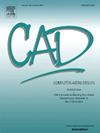基于虚拟拓扑的薄壁结构中面网格抽象
IF 3.1
3区 计算机科学
Q2 COMPUTER SCIENCE, SOFTWARE ENGINEERING
引用次数: 0
摘要
本研究的目的是提出一种基于虚拟拓扑的中面网格抽象方法。首先,将复杂模型分解为简单体,并对这些简单体的单侧面进行虚拟拓扑操作。然后,生成单侧面的虚拟拓扑网格。以这些虚拟拓扑网格为初始网格,采用新开发的局部网格投影算法,可以有效地获取较简单体的中表面网格,并具有较高的精度。结合简单体的中面网格,可以建立原始实体模型的中面网格。建议方法的主要特点包括:(1)通过模型分解降低模型复杂度;(2)利用虚拟拓扑操作提高初始网格质量;(3)利用局部网格投影算法,与传统的CAT方法精确控制中面网格的类型和大小相比,可以方便地访问高质量的中面网格,而无需进行复杂的网格划分。(4)在将中曲面网格转换为薄壁结构的过程中减少人机交互。最后通过实例验证了该方法的有效性和可行性。本文章由计算机程序翻译,如有差异,请以英文原文为准。
Mid-surface mesh abstraction for thin-walled structures based on virtual topology
The objective of this study is to propose a virtual topology-based mid-surface mesh abstraction method. Firstly, the complex model is decomposed into simpler volumes, and virtual topology operations are performed on unilateral faces of these simpler volumes. Subsequently, virtual topology meshes of unilateral faces are generated. With these virtual topology meshes served as initial meshes, mid-surface meshes of the simpler volumes can be effectively acquired with high accuracy by using the new-developed local mesh projection algorithm. With the combination of the mid-surface meshes of the simpler volumes, the mid-surface mesh of the original solid model can be established.
Key features of the proposed method include: (1) reducing model complexity through model decomposition, (2) enhancing initial mesh quality using virtual topology operations, (3) by utilizing local mesh projection algorithms, high-quality mid-surface meshes can be easily accessible without the need for complex mesh partitioning, compared to traditional CAT methods which accurately control the type and size of mid-surface meshes, and (4) reducing human–computer interaction in the process of converting mid-surface meshes to thin-walled structures. Finally the effectiveness and feasibility of the proposed method has been demonstrated through several cases.
求助全文
通过发布文献求助,成功后即可免费获取论文全文。
去求助
来源期刊

Computer-Aided Design
工程技术-计算机:软件工程
CiteScore
5.50
自引率
4.70%
发文量
117
审稿时长
4.2 months
期刊介绍:
Computer-Aided Design is a leading international journal that provides academia and industry with key papers on research and developments in the application of computers to design.
Computer-Aided Design invites papers reporting new research, as well as novel or particularly significant applications, within a wide range of topics, spanning all stages of design process from concept creation to manufacture and beyond.
 求助内容:
求助内容: 应助结果提醒方式:
应助结果提醒方式:


